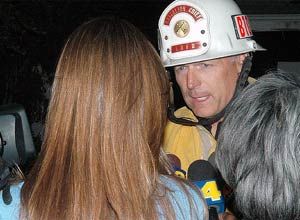| Editor’s note: For more tips on handling the media – and how best to communicate key messages to the community – check out our feature from last year, “Fire Departments in Media Spotlight.” |
 Photo Mike Meadows A Los Angeles battalion chief speaks to the media following a mudslide that damaged a house in the city earlier this year. |
You’re the first-in officer on a structure fire in an apartment building. When you arrive, you see smoke and flames coming from at least two units. You and your crew initiate firefighting operations and assist with the rescue of one person from the building. You later hear that several other people were rescued from the building by firefighters and that there were a couple injuries, and perhaps even a fatality among those evacuated.
More than an hour into the operation, you are taking a short break by the engine when suddenly the local TV news reporter shoves a microphone in your face and says, “Captain, I understand you were the first officer on the scene. What did you see? What is the current status of the fire? Has anyone been hurt?” How will you respond?
Many firefighters would be tempted to respond in a negative or even hostile manner when faced with such questions. Maybe they don’t trust the media because of past experience with distorted or inaccurate reporting. Maybe they resent the reporter’s intrusion into an emergency scene. Maybe they’ve been advised — or even ordered — not to speak to the press under any circumstances. So they turn away, ignoring the request for information, or maybe even berating the reporter for crossing into the fire zone without permission. At best, these officers will give a terse “No comment.”
But all of these reactions would be a mistake, and not in the best interests of either the fire department or the media. For a better outcome, try reframing the fire department/media relationship and your role in it.
Understand first that the reporter is on the scene with a specific job to do, just as you are. The jobs you each have are not the same, but they are not mutually exclusive either. You are there to mitigate harm and the reporter is there to tell the story. The reporter will tell a story, whether you assist with that effort or not. When the news media get the story right, they can be a tremendous asset to the fire service.
Best response
So how should you respond to the questions asked? The best way is to give clear, concise answers that in no way compromise the integrity of the scene.
First, make sure the conversation is taking place in a safe environment. If not, and you have some mobility, move with the reporter to a safe area for a few minutes. If the area is not safe for a civilian, and you cannot move, politely explain the need for the reporter to leave the immediate area and direct him or her to someone else who can help.
Be prepared to give only information that is indisputable from your own observation and experience. For example, if you know you were the first at the scene, you can confirm that fact. You can reiterate what you saw and reported by radio upon arrival, such as, “We observed smoke and flames from the west side of the building when we arrived.” All of this is a matter of public record anyway, but most reporters will be appreciative to hear it directly from you.
What you should not say is anything speculative. When asked about rescues and casualties, you can safely say that at least one person was rescued from the building by the fire department, because it was your crew who did it. Do not pass on second hand information. Tell the reporter that the incident is ongoing, and that the incident commander or public information officer will have more complete information. Direct the reporter to the incident command post, and return to your work.
This entire encounter will take only a few minutes, but the payoff can be huge. If you treat the reporter with professional respect and provide even a little information, the reporter will be grateful and remember you -- and the fire department generally — as helpful, cooperative team players. If on the other hand you are rude, dismissive or even threatening, the reporter will remember this too, and the tone of the encounter is likely to not only influence the resulting story, but also future interactions between the local media and the fire department.
Some fire departments have become so fearful of media encounters that they have developed policies forbidding anyone but the incident commander from speaking to the media for any reason. These kinds of policies put company officers in a very awkward position when asked a direct question. Responding with “I’m not allowed to talk to you” creates a cloud of suspicion that implies that something is being hidden. It is better instead to train all firefighters in how to appropriately deal with the media, including what to say and what not to say. Such advance preparation empowers firefighters in their roles and greatly enables a better fire department/media relationship. When this relationship works well on both sides, it is truly a winning proposition for all involved.


